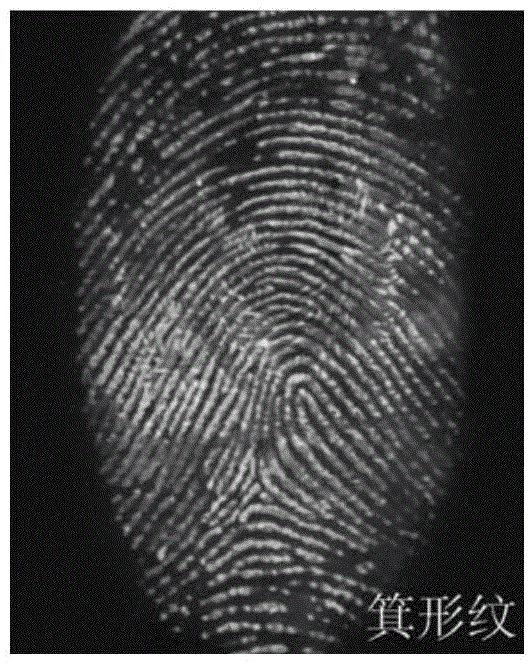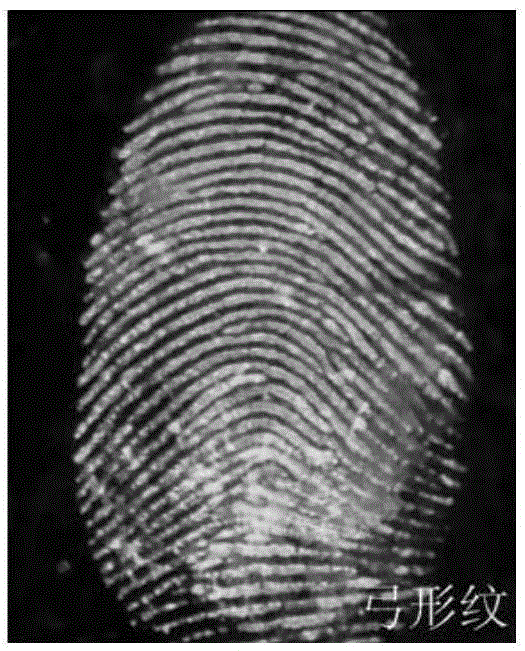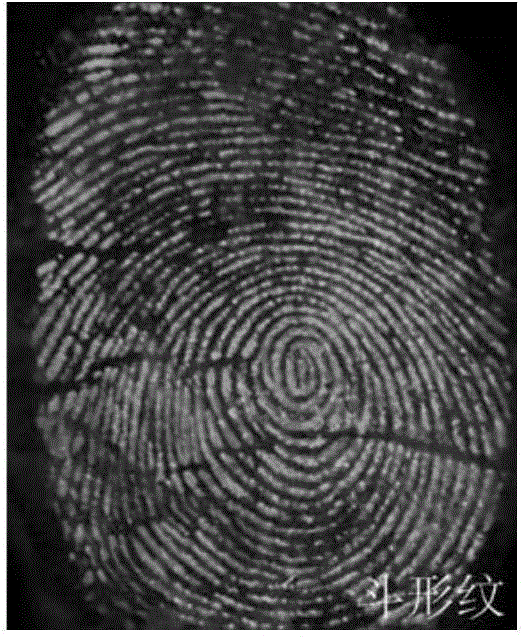Method of appearing and storing latent fingerprints on basis of semiconductor polymer quantum dots
A polymer, quantum dot technology, applied in human identification, diagnostic recording/measurement, medical science, etc., can solve problems such as no relevant reports, and achieve the effects of reducing background interference, fluorescence stability, and high sensitivity
- Summary
- Abstract
- Description
- Claims
- Application Information
AI Technical Summary
Problems solved by technology
Method used
Image
Examples
Embodiment 1
[0052] Embodiment 1: cross-linkable polymer quantum dot do-PFO shows latent fingerprint (attachment figure 1 )
[0053] 1 Synthesis of polymer do-PFO:
[0054] Take a 50mL round bottom flask and weigh 9,9-bis[3-methyl-3-(6-hexyl)methyl ether-oxetane]2,7-dibromofluorene (346.3mg, 0.5mmol) , 2,7-bis(4,4,5,5-tetramethyl-1,3-dioxo-2-boryl)-9,9-dioctylfluorene (321.3mg, 0.5mmol), tetra Butylammonium bromide (6.4mg, 0.02mmol) was dissolved in toluene (10mL), then aqueous sodium carbonate solution (6mL, 2M) was added, and nitrogen was evacuated. Then tetrakis(triphenylphosphine) palladium (10mg, 0.008mmol) was added, heated to reflux at 90°C for 48 hours, and then (4,4,5,5-tetramethyl-1,3,2-dioxaborin -2-yl)benzene (30 mg), refluxed for 5 hours, added bromobenzene (0.3 mL), continued heating for 6 hours, and stopped the reaction. Cool to room temperature, wash the reactant 3 times with ammonia water, extract 3 times with chloroform, backwash 3 times with deionized water, take the...
Embodiment 2
[0062] Embodiment 2: cross-linkable polymer quantum dot do-PF10BT shows latent fingerprint (attachment figure 2 )
[0063] Same as the steps in Example 1, the difference is that the polymer do-PFO was synthesized in step 1 of Example 1, and the polymer do-PF10BT was synthesized in Example 2: Take a 50mL round bottom flask and weigh 9,9- Bis[3-methyl-3-(6-hexyl)methyl ether-oxetane]2,7-dibromofluorene (277.0 mg, 0.4 mmol), 4,7-dibromo-2,1, 3-Benzothiadiazole (29.4mg, 0.1mmol), 2,7-bis(4,4,5,5-tetramethyl-1,3-dioxo-2-boryl)-9,9 - Dioctylfluorene (321.3mg, 0.5mmol), tetrabutylammonium bromide (6.4mg, 0.02mmol) were dissolved in toluene (10mL), then aqueous sodium carbonate solution (6mL, 2M) was added, and nitrogen was evacuated. Then tetrakis(triphenylphosphine) palladium (10mg, 0.008mmol) was added, heated to reflux at 90°C for 48 hours, and then (4,4,5,5-tetramethyl-1,3,2-dioxaborin -2-yl)benzene (30 mg), refluxed for 5 hours, added bromobenzene (0.3 mL), continued heating...
Embodiment 3
[0064] Embodiment 3: crosslinkable polymer quantum dot do-PF5DTBT shows latent fingerprint (attachment image 3 )
[0065] Same as the steps in Example 1, the difference is that the polymer do-PFO was synthesized in step 1 of Example 1, and the polymer do-PF5DTBT was synthesized in Example 2: Take a 50mL round bottom flask and weigh 9,9- Bis[3-methyl-3-(6-hexyl)methyl ether-oxetane]2,7-dibromofluorene (311.7 mg, 0.45 mmol), 4,7-bis(2-bromo-5 -thienyl)-2,1,3-benzothiadiazole (22.9 mg, 0.05 mmol), 2,7-bis(4,4,5,5-tetramethyl-1,3-dioxo-2 -boryl)-9,9-dioctylfluorene (321.3mg, 0.5mmol), tetrabutylammonium bromide (6.4mg, 0.02mmol) was dissolved in toluene (10mL), then aqueous sodium carbonate (6mL, 2M), vacuumize and pass nitrogen. Then tetrakis(triphenylphosphine) palladium (10mg, 0.008mmol) was added, heated to reflux at 90°C for 48 hours, and then (4,4,5,5-tetramethyl-1,3,2-dioxaborin -2-yl)benzene (30 mg), refluxed for 5 hours, added bromobenzene (0.3 mL), continued heating...
PUM
 Login to View More
Login to View More Abstract
Description
Claims
Application Information
 Login to View More
Login to View More - R&D
- Intellectual Property
- Life Sciences
- Materials
- Tech Scout
- Unparalleled Data Quality
- Higher Quality Content
- 60% Fewer Hallucinations
Browse by: Latest US Patents, China's latest patents, Technical Efficacy Thesaurus, Application Domain, Technology Topic, Popular Technical Reports.
© 2025 PatSnap. All rights reserved.Legal|Privacy policy|Modern Slavery Act Transparency Statement|Sitemap|About US| Contact US: help@patsnap.com



